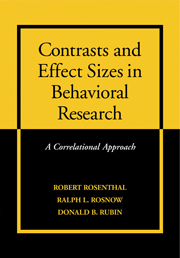6 - Multiple Contrasts
Published online by Cambridge University Press: 18 April 2011
Summary
Our emphasis in the first five chapters has been on the computation of an individual contrast, the various effect size correlations associated with an individual contrast, and the significance level associated with it. It is often the case, however, that we want to compute multiple contrasts. Our purpose in this chapter is to address a number of issues arising when computing multiple contrasts.
In the preceding chapters, the emphasis has been on the planning and computation of single contrasts. Here and there in the preceding chapters, we have alluded indirectly to the topic of multiple contrasts, but we continued to treat each of several possible contrasts as though it were the only one being considered (i.e., Chapter 3, pp. 51–52; Chapter 4, pp. 77–79, 98–101; Chapter 5, pp. 133–136, 138–140).
In this chapter, we deal specifically with the situation of multiple contrasts. The major topics addressed include (a) the relationships among contrasts, (b) the comparison of competing contrasts, and (c) the analysis of contrasts that were computed only after we examined the data.
RELATIONSHIPS AMONG CONTRASTS
Orthogonal Contrasts
When two sets of contrasts are uncorrelated with one another, they are said to be orthogonal. This orthogonality means that each contrast, as defined by its weights, pertains to a distinctly different prediction. In a set of results based on k conditions, we can compute up to k−1 such orthogonal contrasts. Contrasts are orthogonal when the sum of the products of the corresponding weights (λs) is zero.
- Type
- Chapter
- Information
- Contrasts and Effect Sizes in Behavioral ResearchA Correlational Approach, pp. 151 - 184Publisher: Cambridge University PressPrint publication year: 1999
- 1
- Cited by



